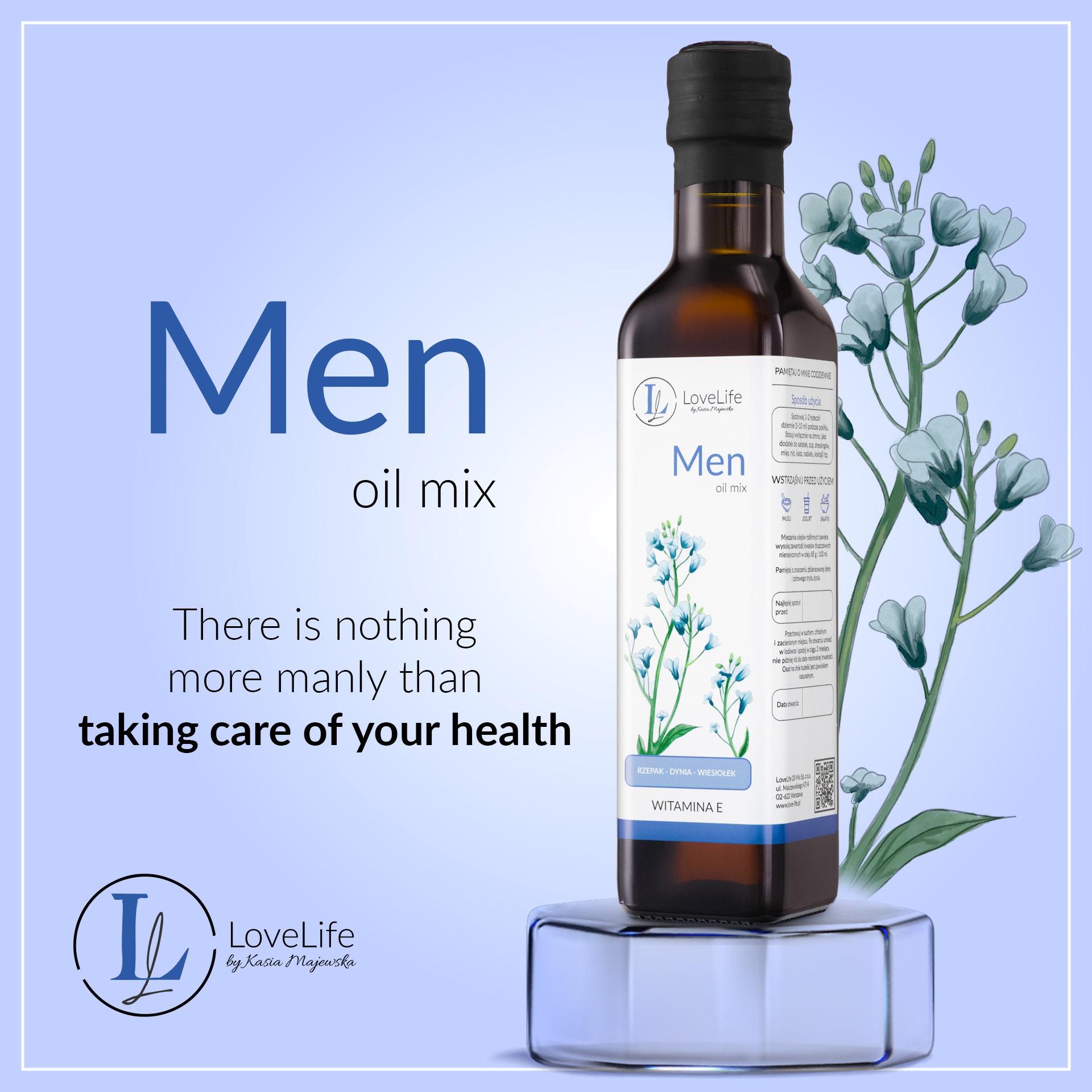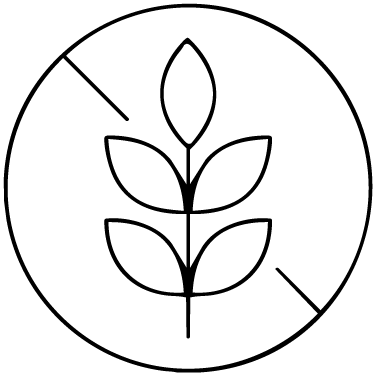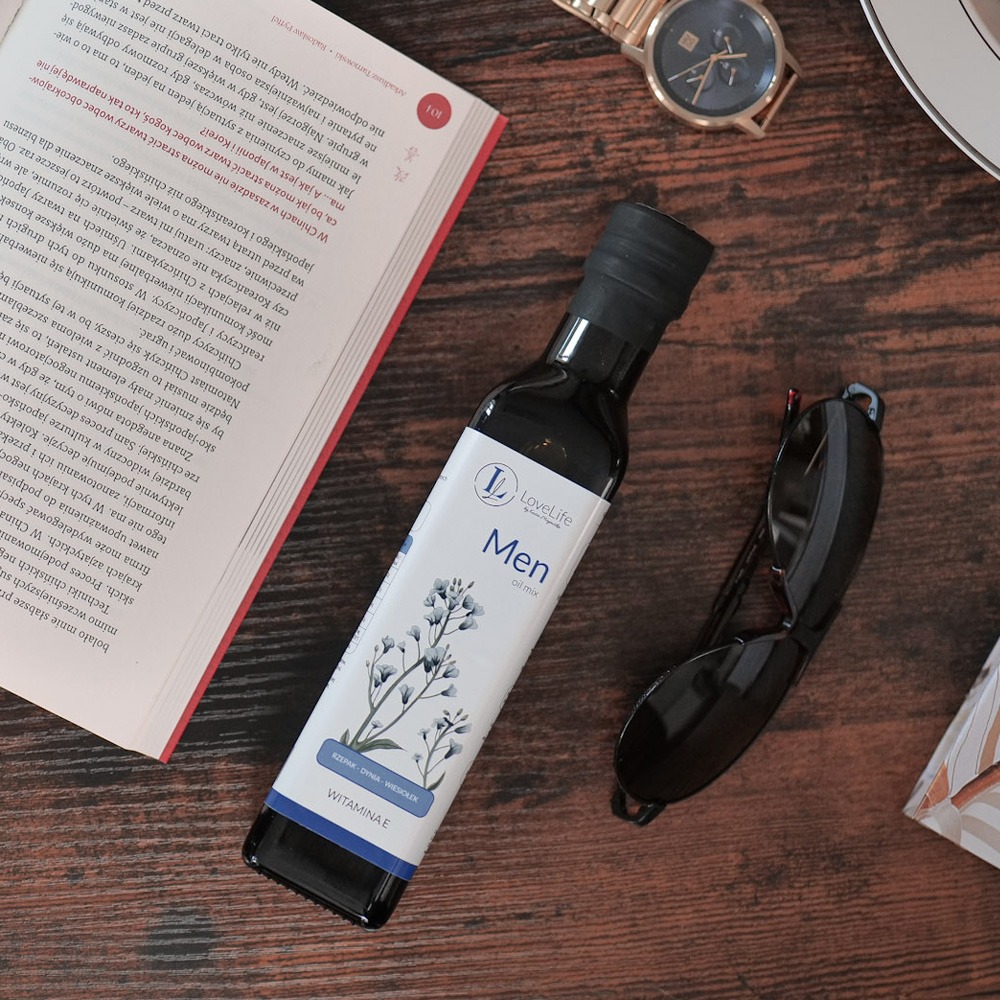LoveLife Men

LoveLife Men
Available sizes:
There is nothing more masculine than taking care of your health
Made from:
- Rapeseed (91%)
- Pumpkin (5%)
- Evening Primrose (4%)
After opening, we recommend storing the product on glass or metal shelves in the refrigerator.
NOTE: LoveLife Men has a shelf life of approximately 9 months.
Shipping time: since May 5, 2025 processed in the order received.

Vitality and energy

Prostate protection

Anti-atherosclerotic effects

Gluten-free
Properties
How LoveLife Men Affects Men's Health
- Helps maintain cardiovascular health by positively influencing total cholesterol levels and LDL fractions in the blood.
- Protects against atherosclerosis and its complications—stroke and heart attack.
- Exhibits anticancer effects.
- Has strong antioxidant properties and contributes to the protection of the prostate gland, preventing hyperplasia and prostate cancer.
- Improves skin condition and increases hydration.
The composition of oils, based on the highest quality rapeseed oil, enriches the diet with essential unsaturated fatty acids in the most appropriate proportions, acting anti-inflammatory and preventively in the context of many civilization diseases. It is enriched with components of high anticancer potential, providing protection for the prostate.
The product is a blend of cold-pressed oils, which are highly susceptible to oxidation due to environmental factors such as temperature and sunlight.
Depending on the production batch, the oil may vary slightly in color, taste, and cloudiness.
Use only cold! Do not expose to heat. Store in a cool, dry, and dark place. Once opened, keep refrigerated to preserve its full properties and health benefits.
For your safety: if you are under regular medical care, receiving treatment for a chronic condition, or have been diagnosed with any medical issues, it is advisable to consult your doctor before using oils.

Ingredients
Rapeseed Oil
It is valued for its very favourable fatty acid composition in terms of diet—low in saturated fatty acids and high in polyunsaturated ones, including a relatively high omega-3 content. The significant value of rapeseed oil as a functional food is also attributed to its high content of bioactive compounds such as tocopherols, sterols, phenolic compounds, carotenoids, and phospholipids.
Tocopherols are a group of compounds known as vitamin E. They are an important group of antioxidants that protect the body from free radicals and oxidative stress.
Provision of rapeseed oil with the diet regulates cholesterol concentrations and inhibits lipid peroxidation.
Due to its high content of monounsaturated fatty acids (MUFA), rapeseed oil plays a positive role in preventing cardiovascular diseases by regulating lipid levels, susceptibility to LDL cholesterol oxidation, and insulin sensitivity
Replacing commonly used dietary fats with rapeseed oil also results in lower fasting glucose and insulin levels and improved control of type 2 diabetes.
Pumpkin
A valuable health-promoting component found in pumpkin seed oil is phenolic acids, which participate in neutralising free radicals, thereby preventing lipid oxidation. As a result, they exhibit anti-atherosclerotic and protective effects on the cardiovascular system. Research findings indicate the protective influence of pumpkin seed oil against coronary artery disease (the mechanism is associated with the formation of nitric oxide).
Phenolic acids also prevent skin damage caused by UV radiation.
Caffeic acid and ferulic acid are inhibitors of cancer diseases and limit the formation of mutagenic compounds (nitrosamines) and carcinogens.
The presence of polyphenolic compounds from pumpkin in the diet indicates a reduced risk of prostate cancer. They induce programmed cell death in cancer cells.
These compounds exhibit choleretic, antibacterial, and immune-supporting effects. They have a positive impact on the liver, promote bile secretion, and participate in the elimination of toxins and drugs.
Tocopherols counteract the development of atherosclerosis by maintaining appropriate thickness of blood vessel walls and acting preventively in platelet adhesion and aggregation.
Active vitamin E compounds (tocotrienols) exhibit neuroprotective effects, reducing the risk of developing Parkinson’s, Huntington’s, and Alzheimer’s diseases
A valuable component of pumpkin oil is squalene, which is characterised by exceptionally strong antioxidant properties. In the human body, squalene serves as a precursor in the synthesis of vitamin D, steroid hormones, cholesterol, and bile acids. It enhances the immune system by stimulating lymphocytes and macrophages.
Evening Primrose Oil
Gamma-linolenic acid (GLA) is a very important acid for our body.
Due to its conversion to PGE1,1 it exhibits anti-inflammatory, anti-thrombotic, anti-proliferative effects, and lowers lipid levels in the blood serum.
GLA is one of the building blocks of phospholipid cell membranes. It plays a crucial role in repair processes and strengthens the skin barrier. When used as a dietary component, it penetrates into the dermis and prevents excessive water loss, enhancing the barrier that protects against the ingress of bacteria, toxins, fungi, and allergens from the outside.
Scientific studies show that it is effective in the prevention and treatment of rheumatoid arthritis, atopic dermatitis, allergies, atopic eczema, and psoriasis.
Evening primrose oil is an effective aid for weight loss, as GLA stimulates brown adipose tissue and increases the rate of metabolic processes, leading to fat burning.
Nutritional values
| Nutritional Value | 100 ml | 2 teaspoons = 10 ml |
| Energy | 3404 kJ/ 828 kcal | 340 kJ/ 83 kcal |
| Fat | 92 g | 9,2 g |
| saturated fatty acids nasycone | 7 g | 0,7 g |
| polyunsaturated fatty acids | 54 g | 5,4 g |
| monounsaturated fatty acids | 31 g | 3,1 g |
Contains negligible amounts of carbohydrates, sugars, protein, and salt.
1:1 ratio of OMEGA-3 and OMEGA-6 fatty acids
OMEGA-3 (12 g/ 100 ml)
OMEGA-6 (19 g/ 100 ml)
OMEGA-9 (51 g/ 100 ml)
VITAMIN E (87 mg/100 ml)
Cold-pressed, unrefined. High content of unsaturated fats; alpha-linolenic acid (ALA) from the OMEGA-3 family (85 g/100 ml) helps maintain normal blood cholesterol levels. A beneficial effect is obtained with a daily intake of 2 g ALA (≈ 10 ml of oil).
Directions for use: 2 teaspoons once daily with a meal.
Store in a cool, dry, and dark place. After opening, keep refrigerated. Sediment at the bottom of the bottle is a natural phenomenon. Consume within 2 months of opening.
REVIEWS
LoveLife Men
Godny polecenia🙂
LoveLife Men
Wspaniały
LoveLife Men
OK
Bibliography
- Białek M., Rutkowska J., Znaczenie kwasu y-linolenowego w profilaktyce i terapii, „Postępy Higieny i Medycyny Doświadczalnej” 2015, nr 69.
- Chmielewska, M., Tys, J., Petkowicz, J., Petkowicz, B. (2018). Żywność–po pierwsze nie szkodzić (artykuł przeglądowy). Acta Agrophysica, 25(1).
- Duraj, K., & Palacz-Wróbel, M. (2021). Multi-directional effect of primrose oil on organism. Medycyna Rodzinna.
- Eldahshan OA, Singab ANB. Carotenoids. J Pharmacogn Phytochem 2013, 2(1): 225-234.
- El-Mosallamy AE, Sleem AA, Abdel-Salam OM, et al. Antihypertensive and cardioprotective effects of pumpkin seed oil. J Med Food 2012, 15(2): 180-189.
- Gawlik-Dziki U. Fenolokwasy jako bioaktywne składniki żywności. Żywn Nauk Technol Jakość 2004, 4(41): 29-40.
- Gugała M, Zarzecka K, Sikorska A. Prozdrowotne właściwości oleju rzepakowego. Postępy Fitoterapii. 2014; 2: 100–103.
- Helwich, M. Wpływ interwencji dietetycznej na stężenie wybranych adipocytokin w ślinie osób otyłych. Kolegium Nauk Medycznych Uniwersytet Medyczny im. Karola Marcinkowskiego w Poznaniu, Poznań, 2021
- Hodson L, Skeaff CM, McKenzie JE, et al. The effect of replacing dietary saturated fat with polyunsaturated or monounsaturated fat on plasma lipids in free-living young adults. Eur J Clin Nutr. 2001; 55(10): 908–915, doi: 10.1038/sj.ejcn.1601234, indexed in Pubmed: 11593354.
- Jopkiewicz, S. Tłuszcze i oleje roślinne. PROBLEMY NAUK MEDYCZNYCH I NAUK O ZDROWIU, 47. Exante Wydawnictwo Naukowe, Wrocław 2018
- Nogala-Kałucka M, Siger A. Tokochromanole – bioaktywne związki roślin oleistych. Od biosyntezy do biomarkerów. Rośliny Oleiste – Oilseed Crops 2011, 32(1): 9-28.
- Sicińska P, Pytel E, Kurowska J, Koter-Michalak M: Suplementacja kwasami omega w różnych chorobach. Postepy Hig Med Dosw 2015; 69: 838-852
- Simon D, Eng PA, Borelli S, et al. Gamma-linolenic acid levels correlate with clinical efficacy of evening primrose oil in patients with atopic dermatitis. Adv Ther. 2014;31(2):180-188.
- Siudem, P. (2022). Wybrane zioła w prewencji i wspomaganiu leczenia wirusowych infekcji dróg oddechowych. Lek w Polsce, 375(07-08), 13-20.
- Srbinoska M, Hrabovski N, Rafajlovska V, SinadinovićFišer S. Characterization of the seed and seed extracts of the pumpkins cucurbita maxima D. and cucurbita pepo L. from Macedonia. Maced J Chem Chem Eng 2012, 31(1): 65-78.
- Winiarska-Mieczan A, Samolińska W, Kowalczuk-Vasilev E, eds. Czynniki żywieniowe a stan skóry, włosów i paznokci. Fizjologia, dietoterapia, suplementy diety, bezpieczeństwo i skuteczność terapii, toksykologia. Lublin: Wyd. UP w Lublinie; 2022.